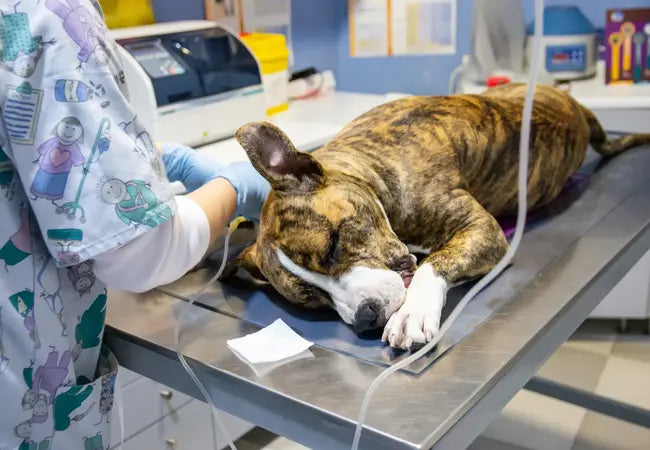Vet‑Approved 2025 Guide: Dog Anesthesia – Safe Protocols, Risks & Tailored Care 🐶💉

In this article
Vet‑Approved 2025 Guide: Dog Anesthesia – Safe Protocols, Risks & Tailored Care 🐶💉
By Dr. Duncan Houston BVSc
Anesthesia in dogs—when done right—is a lifeline for surgeries, diagnostics, and comfort care. Derived from Greek for “without sensation,” it ensures dogs feel no pain and remain unconscious during invasive procedures. 🧠🐶 In 2025, advanced protocols and monitoring technologies have made anesthesia safer than ever, but pet owners still play a key role. This guide, written by Dr. Duncan Houston BVSc, will walk you through when anesthesia is needed, how it works, drug options, risks, monitoring, recovery, breed considerations, and supportive tools like Ask A Vet, to help your pup rest easy.
🔍 What Is Anesthesia?
Anesthesia blocks nerve signals and induces unconsciousness for procedures such as surgery, dental cleaning, biopsy, or fracture repair. Sedation is milder—it relaxes but doesn’t eliminate pain awareness.
📌 When Is It Used?
From routine spays/neuters to critical emergency interventions, anesthesia is essential when any procedure may cause pain or require immobilization. Common uses include:
- Spay/neuter, mass removal, biopsies
- Dental cleaning and extractions
- Orthopedic surgeries, fracture repair
- Diagnostic imaging (CT/MRI, endoscopy)
- Emergency procedures: foreign body removal, wound repair
🔧 Types of Anesthesia Used in Dogs
- General anesthesia: Induces unconsciousness and loss.
- Local anesthesia: Numbs a small area; the dog remains awake.
- Regional/nerve blocks: Provide targeted numbing during surgery.
- Sedation: Calming agent with mild anesthesia; the dog may still respond to strong stimuli.
🧪 Drug Protocols & Co‑induction
A balanced anesthesia protocol combines drugs to improve safety, reduce side effects, and smooth recovery. Common stages:
- Premedication: Sedatives (e.g., medetomidine/dexmedetomidine) are often paired with opioids.
- Induction: IV agents like alfaxalone or propofol quickly bring the dog under.
- Maintenance: Inhalant gases (isoflurane, sevoflurane) keep the dog asleep during the procedure.
- Reversal agents: Atipamezole reverses alpha-2 agonist sedation.
📋 Monitoring During Anesthesia
Modern protocols include:
- ECG, blood pressure, pulse-oximetry (SpO₂)
- Body temperature monitoring
- Capnography (CO₂ levels)
- Fluid lines via IV catheter—often placed pre-op for drug/fluid access
A trained technician or ACVAA-certified vet oversees this—vital for safety.
⚠️ Risks & Complications
While rare in healthy dogs, complications can include:
- Mild nausea or vomiting post-op.
- Respiratory depression—especially with drugs like alfaxalone.
- Cardiac instability—hypotension, arrhythmias.
- Delayed recovery—poor quality wake-up in some dogs.
- Allergic or idiosyncratic drug reactions.
Mortality risk in healthy dogs is low: approx. 1:1849; in sick dogs it's higher—about 1:75.
⏳ Anesthesia Recovery & At-Home Care
Recovery often takes 24‑48 hours in monitored care. Watch for:
- Disorientation, wobbliness, or restlessness
- Mild lethargy or decreased appetite—normal early on.
- Nausea/vomiting—common, but monitor closely.
- Hypothermia—keep pup warm and dry.
- Monitor IV site (if still in place) for swelling or infection.
Use calming tools like Woopf anxiety wraps, Purrz pheromone diffusers, and soft chew mats. For post‑op recovery questions, use Ask A Vet for remote, expert guidance.
🐾 Breed & Age Considerations
- Brachycephalic Dogs (Pugs, Bulldogs): High risk for airway obstruction—often require specialized prep and recovery.
- Senior Dogs: Reduced organ function means slower metabolism—doses tailored carefully.
- Tiny & Toy Breeds: Use smaller catheter/gas doses and warmed fluids to prevent hypothermia.
✅ Best Practices for Pet Parents
- Ensure full pre-op health screening (bloodwork, exam)
- Avoid food 8‑12 hrs pre-op to prevent vomiting.
- Bring comfort items—blanket, favorite toy—for post-op.
- Ask questions about drug protocols and monitoring steps.
- Schedule calm recovery at home—no strenuous activity for 24–48 hrs.
🚨 When to Contact Your Vet
Contact them if you notice:
- Persistent vomiting, diarrhea, or refusing food beyond 24 h
- Shaking, shivering, seizures
- Unresponsiveness, weakness, or collapse
- Labored breathing or prolonged coughing
🏁 Final Thoughts
In 2025, dog anesthesia will be safer and more effective thanks to advanced drugs, monitoring, and personalized protocols. As a vet, my priority is a pain-free procedure and smooth recovery. With educated pet owners, supportive tools from Ask A Vet, and thoughtful care, your pup’s anesthesia journey can be low-risk and stress-free.
Need more support? Visit Ask A Vet or download the app for live expert advice tailored to your dog. 🐾❤️


